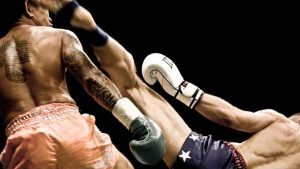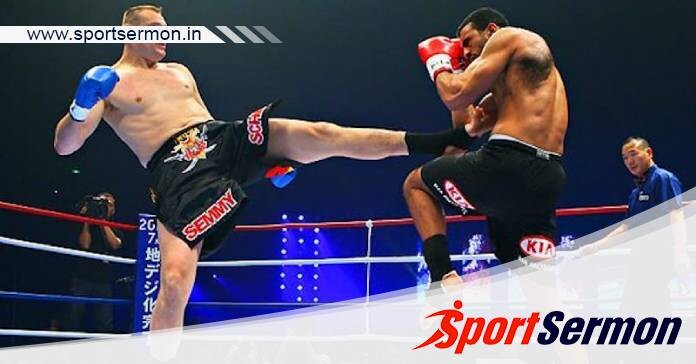Dutch Kickboxing vs Muay Thai: One of the fiercest rivalries in combat sports has traditionally been centred on the Dutch kickboxing and Muay Thai scenes. For almost as long as boxing, these two styles of kickboxing have dominated the striking scene. Combat sports using mixed martial arts allow practitioners of various fighting styles to compete against one another.
One specific kickboxing style that originated in the Netherlands is known as Dutch kickboxing. It’s become so popular that some now identify it as a separate kickboxing style. The kickboxing technique known as muay thai was first created for actual fights. It lets you employ additional body parts—like your knees and elbows—as weapons.
An Understanding of Dutch Kickboxing and Muay Thai

To better comprehend these two different kickboxing methods, let’s take a closer look at them separately:
1) Dutch Kickboxing
One technique that is frequently trained in the Netherlands is Dutch kickboxing. Even though it’s now recognised as a distinct fighting technique, other fighting styles including Japanese kickboxing, Muay Thai, Western kickboxing, and Kyokushin Karate have had a significant effect. Kyokushin Karate is the striking discipline that has had the biggest impact on Dutch kickboxing out of these four. It is in charge of the quick tempo and violence that characterises Dutch kickboxing.
Dutch kickboxers usually end their combinations with low kicks and rely heavily on punches rather than kicks. They frequently engage in fast-paced combat, launching several assaults and keeping their momentum going ahead.
When Dutch Karate warriors who had studied Japanese kickboxing and Kyokushin Karate in Japan brought their newfound knowledge back to the Netherlands, kickboxing made its debut in the 1970s. As they integrated Western Boxing and Muay Thai methods into their training, it eventually evolved into a distinct style that is mostly practised in the Netherlands.
Dutch boxers dominated kickboxing in the 1990s and 2000s, winning 15 of the 19 World Grand Prix conducted during that time, demonstrating the effectiveness of the form.
You might also be interested in reading this: Muay Thai Fighters Golden Era and Current Era
2) Muay Thai
Muay Thai was developed in the thirteenth century specifically for fighting. Muay Thai has remained effective throughout the years, in contrast to many other traditional combat methods that have gotten diluted. With the exception of a few rule modifications for competitions—such as switching from traditional rope wraps to Western-style boxing gloves—modern Muay Thai isn’t all that different from the old form.
Thailand’s national sport now is muay thai, which is regarded by many as the most efficient striking-based martial art. Naturally, practitioners of Dutch kickboxing would contest such an evaluation.
Muay Thai, sometimes referred to as “the art of eight limbs,” permits the use of the fist, elbow, knee, and shin as weapons. Additionally, it enables fighters to toss their opponents to the ground or engage in clinch fighting. When boxing gloves, timed rounds, and boxing rings were introduced in the early 20th century, the style underwent its most recent alterations. It is still the most well-liked sport in Thailand, and its appeal is spreading around the world.
Compared to Dutch kickboxing, Muay Thai has a stronger sense of tradition since its competitors practise ritual dances called Wai Kru before fights. Their heads and arms are decked with ceremonial attire, and traditional Sarama music is performed as they approach the ring.
In the 1990s and early 2000s, Muay Thai fighters began to compete in the World Grand Prix, which led to the emergence of mixed martial arts and the sport’s global recognition. Many Westerners travelled to Thailand to learn and fight in mixed martial arts (MMA), with muay Thai becoming the dominant striking technique very rapidly.
Dutch Kickboxing vs Muay Thai: The Main Distinctions Between Both

Let’s examine in detail some of the key distinctions between Dutch kickboxing and Muay Thai:
Techniques
Numerous boxing punching combinations and techniques are employed in Dutch kickboxing. They also use some unusual moves like the back fist and Superman punch, which are forbidden in boxing. Punching hard and often is what this method teaches.
Another distinctive kicking technique used in Dutch kickboxing is derived from Kyokushin Karate, particularly in low kicks. It entails landing on the shin after crossing the thigh. Since many kickboxing organisations do not permit the use of knees in the clinch, Dutch kickboxers also employ the step-in knee and jumping knees.
Conversely, compared to their Dutch counterparts, Muay Thai fighters do not employ fists as frequently. When they are close and in tight positions, elbows are their favoured strike. In addition, knees play a major role in the sport and are employed in all categories.
In Muay Thai, tipps, or push kicks, are among the most often employed kicking techniques, along with low kicks. But one of the most effective moves used by Muay Thai fighters is the roundhouse kick, which has the ability to stop a battle at any time. Muay Thai fighters utilise their legs as baseball bats, twisting their hips and smashing their shin through their opponents rather than snapping it over their thighs. While it may not be the most accurate or fastest method, it is without a doubt the strongest.
Additionally, Muay Thai fighters block kicks differently. They are trained to use their legs to check any kicks other than roundhouse kicks, but Dutch kickboxers utilise a double arm cross that positions them to counter the kick with a punch.
Guidelines
The laws governing Dutch kickboxing and Muay Thai vary. Muay Thai bouts usually consist of five rounds, each lasting three minutes, and are scored overall. Every succeeding round has greater importance than the previous one.
Fighters are permitted to use their elbows and knees in addition to fighting in the clinch. In Muay Thai, trips, throws, and dumps are all permitted.
Dutch kickboxing is governed by the main kickboxing organisations, such as K-1. Elbows are not allowed, but punches and kicks are. While a knee is allowed, you cannot throw more than one knee in the clinch. Like boxing, kickboxing typically discourages clinch fighting.
Style
Dutch kickboxers are known for their aggressive style, rapid-fire, and heavy punching. Muay Thai fighters, on the other hand, usually take their time getting to know their opponents. The more the struggle lasts, the faster it becomes. Muay Thai fighters often favour single, forceful attacks, whereas Dutch kickboxers sometimes combine many strikes.
These distinctions in fighting styles aren’t absolute though, since many of the best Muay Thai fighters, such as Rodtang, have more of a Dutch style.
Instruction
Kickboxers from the Netherlands often put in their best effort in the gym, although Muay Thai fighters spar less frequently since they fight more frequently. “Sabai” refers to the sparring method used sparingly in Muay Thai.
Which combat style—mixed martial arts or self-defence—is more effective?
Given that both are among the best striking-based martial arts, there is no definitive answer to this query. On paper, though, Muay Thai has a tiny advantage since it permits the use of elbows, trips, throws, and dumps.
Dutch kickboxers who want to switch to mixed martial arts (MMA) need to master all of these techniques as they are all permitted in the sport. However, Muay Thai competitors already possess the equipment necessary to participate in the mixed martial arts standup division.
The same holds true for circumstances involving self-defence. In self-defence scenarios, knowing how to take down an adversary or fight in the clinch might be useful. Nonetheless, Dutch kickboxers are more than competent in self-defence.
This is the difference between Dutch Kickboxing vs Muay Thai. Let us know your thoughts in the comment section below.

